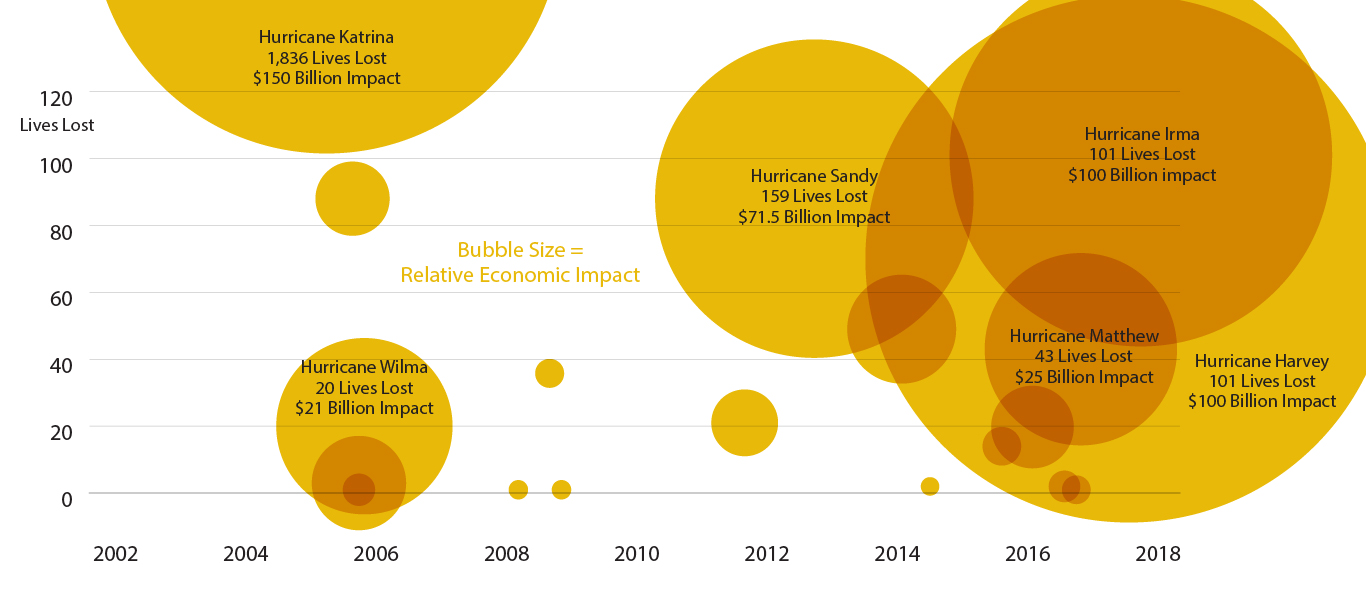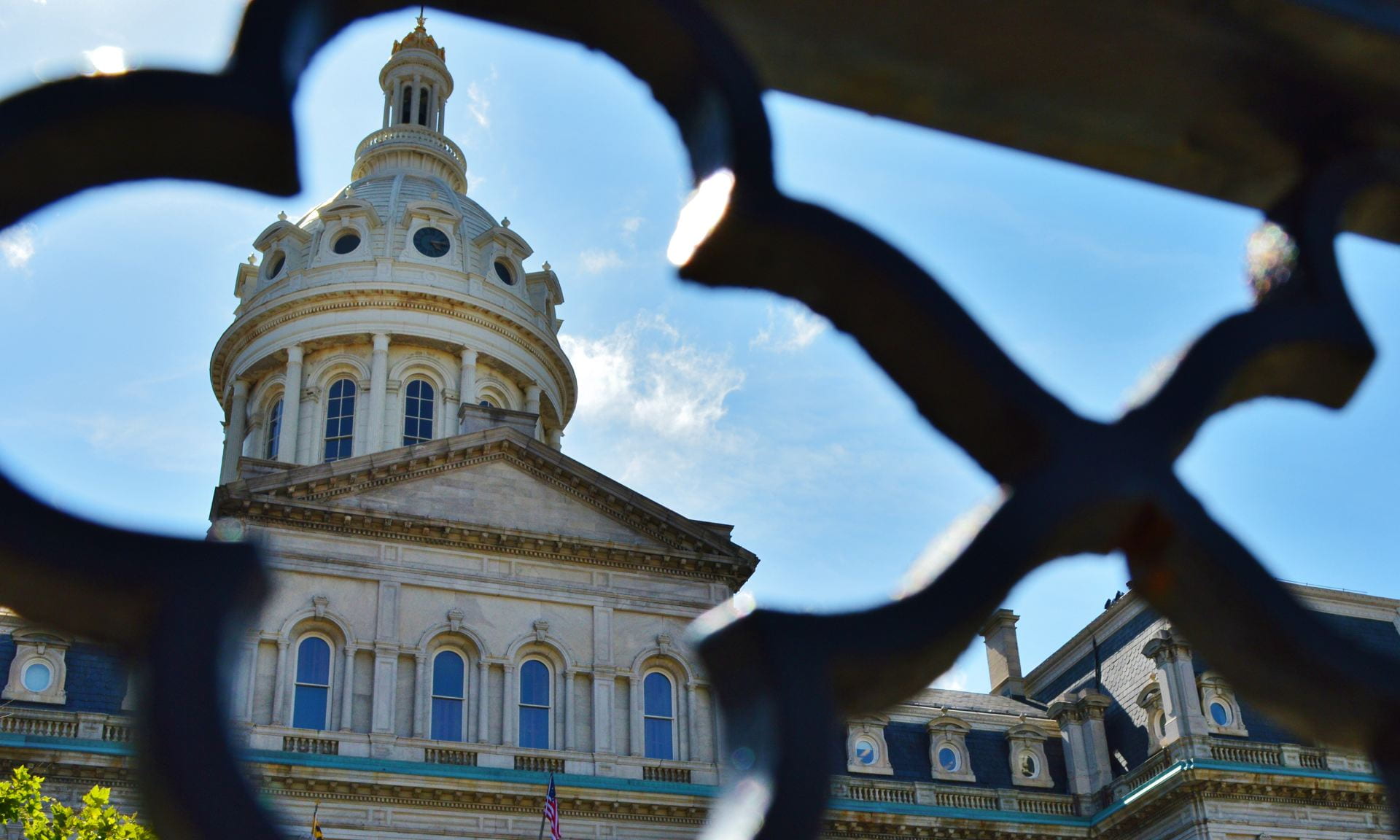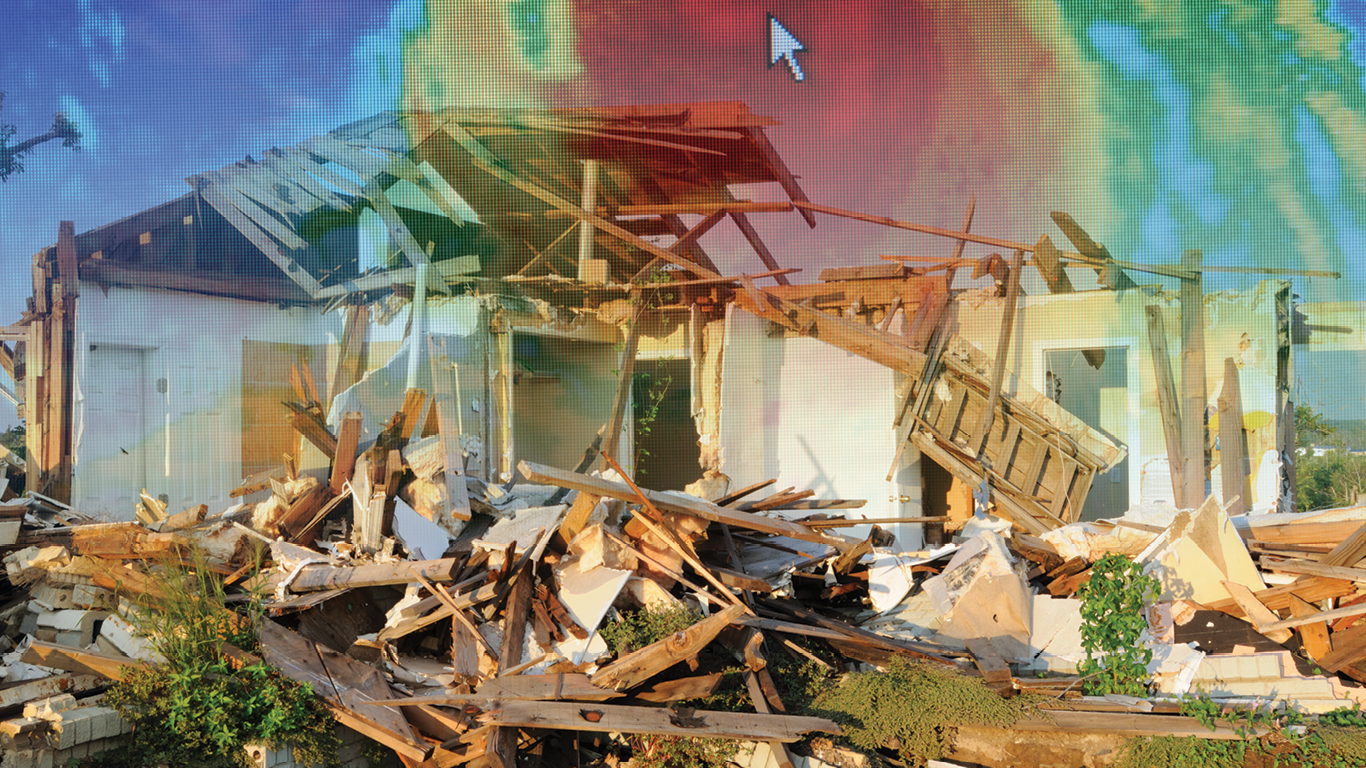Jasmin Farahani
Graduate Student, MS in Marketing Intelligence, Towson University
Tobin Porterfield, Ph.D.
Associate Professor, Department of eBusiness & Technology Management, Towson University
Each new natural disaster rekindles businesses’ interest in taking measures to prevent the next one from hurting their operations. But talk has so far led to little action, even after the big disasters of 2017, Hurricane Maria’s devastating effect on Puerto Rico and the U.S. Virgin Islands, three hurricanes making landfall on the U.S. mainland, multiple earthquakes hitting Mexico and Japan, and a 4.1-magnitude eathquake centered near Dover, Delaware, rocking parts of Maryland. With the frequency and cost of storms rising, business owners should be developing plans, building on the existing efforts to protect and preserve life and property in Maryland.
The devastation of natural disasters is not that surprising – but the economic impact to those regions is shocking. Hurricane Katrina (2005) caused $150 billion in economic damage, Superstorm Sandy (2012) caused $30 billion in economic damage, Hurricane Irma (2017) is still racking up bills but is expected to hit $100 billion, and as the waters recede in Texas and surrounding states, Hurricane Harvey is on track to set a new record of nearly $190 billion and impact 450,000 people¹. Not only households, but also local businesses are severely impacted.
Closer to Home
Maryland is not immune to natural disasters, its coastal location and the extremes of hot humid summers, and low winter temperatures bring hurricanes, tornadoes, floods, snowstorms and ice storms to the region. In July 2016, flooding in Ellicott City impacted 65,000 people and closed the downtown business district for more than two months. The reported economic impact to Ellicott City was $42 million to both households and businesses.²
Figure 1 shows the 20 largest mainland U.S natural disasters from 2005–2017. Each bubble represents one event with the cost in human lives identified on the vertical axis and the relative economic impact represented by the size of the bubble. The frequency of natural disasters increased over the period. However, the number of lives lost has decreased dramatically.
Figure 1: Natural Disasters 2005-2017

We are getting better at moving people out of harm’s way and moving supplies in to aid in recovery. Since Hurricane Katrina, we have witnessed FEMA stepping-up with improved information on family storm preparedness and enhanced procedures for storm response. As individuals, we are regularly reminded to have our home emergency kits stocked with flashlights, batteries, water, and other essentials.
The coordination between private and state agencies has a positive effect on how quickly a region returns to a state of normalcy. The coordination of product flow between the right people at the right time has made a difference in the number of lives lost during a natural disaster and the time it takes to recover. Additionally, as technology advances, the ability to track a storm and detect when and where it will hit has improved. When Hurricane Katrina made landfall near New Orleans, there were 1,836 direct and indirect deaths.⁴ When Hurricane Harvey hit the South and Southeast coast in September 2017, though the economic damage was the highest in history, the number of lives lost was significantly lower (70 deaths).⁵
All Businesses Need to Be Prepared
Businesses of all sizes must also improve their preparedness for natural disasters and learn from the past. Business continuity planning is often part of a large corporation’s risk mitigation strategy. But our economy is driven by small business, are our small to medium-sized firms ready to weather the next storm? Preparedness is a costly endeavor but so is a business failure. For small and medium-sized firms, being ready starts with identifying key relationships and leveraging networks of organizations outside of the region. This includes full documentation and contact information for employees, suppliers, banking, insurance, and legal support.
Customers often do not understand that business operations cannot be conducted the same way following a natural disaster. In the wake of a natural disaster, employees, supplies, computer equipment, refrigeration, and heating and air conditioning may not be fully available. Initial lost sales and longer-term customer loyalty can be at risk. How quickly can your business recover from a natural disaster?
Table 1: Emergency Response Plan Elements Comparison
| Element/State | FL | NC | MD |
| Understanding of Planning Phases and its Components | X | X | X |
| Local and State Government Responsibility | X | X | X |
| Major Stakeholder Responsibilities | X | X | X |
| Mutual Aid Management and Logistics | X | X | |
| Maintenance and Development of Emergency Plan | X | X | X |
| Laws and Guidelines | X | X | |
| Reference Points and Authorities | X | ||
| Acronyms | X | X | X |
| Transportation – Responsibilities and Stakeholders | X | X | |
| Communication – Responsibilities and Stakeholders | X | X | |
| Firefighting – Responsibilities and Stakeholders | X | X | |
| Planning – Responsibilities and Stakeholders | X | X | X |
| Mass Care – Responsibilities and Stakeholders | X | X | |
| Resource Management – Responsibilities and Stakeholders | X | X | |
| Public Health and Medical Services – Responsibilities and Stakeholders | X | X | |
| Search and Rescue – Responsibilities and Stakeholders | X | X | |
| Environmental Protection – Responsibilities and Stakeholders | X | ||
| Food and Water – Responsibilities and Stakeholders | X | X | |
| Energy – Responsibilities and Stakeholders | X | X | |
| Military Support – Responsibilities and Stakeholders | X | X | |
| External Affairs – Responsibilities and Stakeholders | X | ||
| Volunteers and Donations – Responsibilities and Stakeholders | X | X | |
| Law Enforcement and Security – Responsibilities and Stakeholders | X | X | |
| Animal and Agricultural Issues – Responsibilities and Stakeholders | X | X | |
| Business, Industry and Economic Stabilization – Responsibilities and Stakeholders | X | ||
| Disaster Airlift | X | ||
| Public Works Engineering | X | ||
| Hazardous Materials | X | ||
| SERT | X | ||
| Event Specific Plans | X | X |
Lesson from Electric Utilities
Even when a storm does not damage a business’s physical location, regional utility outages can keep the business closed. Having power and water not only affects the business location but also the ability of its employees to maintain their family responsibilities and be available to come into work.
In Central Maryland, BGE is responsible for restoring electric power to help the region return to normal. BGE has learned from the past and not only has its workforce prepared for natural disasters, they have a network of utilities outside the region that are ready to lend a hand.
Throughout the year, preparation for the worst is in full swing at BGE’s operations center in Windsor Mill, Maryland. Drills are conducted twice a year where various scenarios are played out, in order to ensure that all procedures and processes work effectively and efficiently based on a several hundred page playbook. More experienced employees train newer employees so that everyone knows their role in storm restoration.
In the background, mutual aid agreements are in place to ensure that local resources are augmented by trained crews from regions not affected by the storm. BGE’s parent company, Exelon, coordinates with their subsidiaries to create a strong network stretching from the eastern seaboard to Chicago. If Exelon’s resources are not sufficient, mutual assistance groups, such as SEE – Southeastern Electric Exchange, NAMAG – North Atlantic Mutual Assistance Group, and MUGMA – Maryland Utilities Group for Mutual Assistance are ready to step in. And these relationships are reciprocal as we saw BGE crews head to Florida in the wake of Hurricane Harvey.
Businesses Can Prepare and Build Support Networks
We often see companies help in recovery efforts, usually through cash donations or making supplies and material available to start the recovery process. Waffle House restaurants have policies in place that no matter how much damage is incurred, they do anything possible to be open, offer a limited menu and serve the ones affected by the disaster and the first responders.⁶ Walmart donates water and household products after a storm hits. And Home Depot donated $1 million to help those affected by Hurricane Harvey. “Our hearts and full support go out to our communities, customers, and associates that are being impacted by Hurricane Harvey,” said Shannon Gerber, executive director of the Home Depot Foundation.⁷
In an era of virtual networks, we can build assistance networks that will help businesses of any size get back to work in the aftermath of a natural disaster. Suppliers, customers, and even competitors can be part of a solution that speeds recovery.
Preparation is Key to Minimizing Business Disruption
The preparation to expect the worst is critical, to minimize damage to the operations of a business. MEMA – Maryland Emergency Management Agency, the state government agency responsible for providing support whenever local governments are not able to provide the necessary resources, have preparedness plans in places, to make sure organizations, agencies and individuals know what to do and how to prepare for a natural disaster. State emergency response plans are designed for use in a variety of man-made and natural disaster scenarios.
Every state develops its own plan based on their needs, risk, and experience. A comparison of the plans provides some insights on the comprehensiveness of the plans.
Table 1 compares the plan elements for Maryland and two other southeastern states.
The list of thirty plan elements comes from aggregating across all three state’s plans. Florida’s plan addresses 26 of the elements (87%), North Carolina’s plan addresses 25 of the elements (83%), Maryland’s plan addresses seven of the element (23%). It is not surprising that Florida has the most extensive plan given its large geographic footprint, thousands of miles of shoreline and a long history of devastating hurricanes. Plans are scalable for the needs of the organization but we can all learn from the experiences of others.
Forewarned is Forearmed
Planning reduces recovery times and the negative impact of disruptions.8 Experience with prior disasters and the likelihood of future disasters may affect the comprehensiveness of planning, but the nature of disasters is that their level of destruction and when they will strike cannot be precisely predicted.
Every company should have a playbook in place with employees and suppliers trained to know how to respond when disaster strikes. An external support network beyond the region can provide access to critical supplies and services. A plan on the shelf is of no use, ongoing training and practice are necessary to keep the plan current and actionable.
When it comes to natural disasters, Mother Nature always wins the battle but with preparation businesses can recover to stand and fight another day.
References
1 Holmes, F. (2017, September 5). We Looked Into The Effects Of Hurricane Harvey And Here’s What We Found. Retrieved from Forbes: https://www.forbes.com/sites/greatspeculations/2017/09/05/we-looked-into-the-effects-of-hurricane-harvey-and-heres-what-we-found/#4850c9bc76f1
2 Wood, P. (2017, July 28). One year later, Ellicorr City’s Main Street marks rebirth from deadly flood. Retrieved from The Baltimore Sun: http://www.baltimoresun.com/news/maryland/bs-md-ho-ellicott-city-recover-20170727-story.html
3 Polsson, K. (2007-2017). Chronology of Extreme Weather. Retrieved from Worldtimeline: http://worldtimeline.info/weather/
4 Amadeo, K. (2017, September 08). Hurricane Katrina Facts: Damage and Cost. Retrieved from the balance: https://www.thebalance.com/hurricane-katrina-facts-damage-and-economic-effects-3306023
5 Amadeo, K. (2017, September 7). What Are the Facts About Sandy’s Damage and Economic Impact? Retrieved from the balance – US Economy : https://www.thebalance.com/hurricane-sandy-damage-facts-3305501
6 Ergun, Ö., Stamm, J. L. H., Keskinocak, P., & Swann, J. L. (2010). Waffle House Restaurants hurricane response: A case study. International Journal of Production Economics, 126(1), 111-120.
7 Foundation, T. H. (2016, August 28). The Home Depot Foundation Commits $1 Million to Hurricane Harvey Disaster Relief Efforts. Retrieved from PR Newswire Cision: http://www.prnewswire.com/news-releases/the-home-depot-foundation-commits-1-million-to-hurricane-harvey-disaster-relief-efforts-300510015.html
8 Bode, Cand Macdonald, J. (2017). Stages of Supply Chain Disruption Response: Direct Constraining, and Mediating Factors for Impact Mitigation. Decison Sciences, 48 (5), 836-874.

